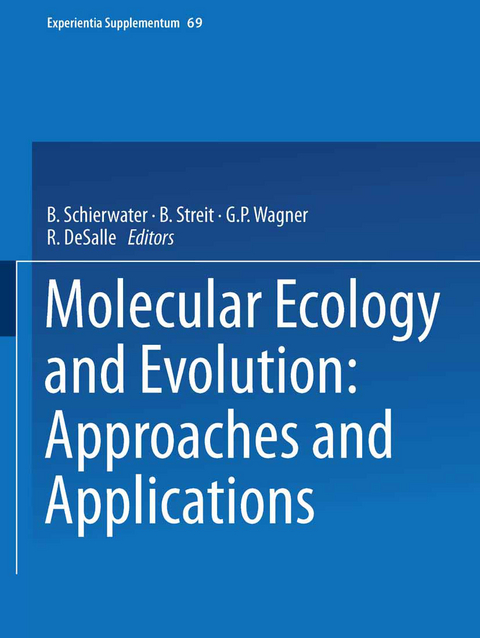
Molecular Ecology and Evolution: Approaches and Applications
Springer Basel (Verlag)
978-3-0348-7529-5 (ISBN)
Bruno Streit ist Professor am Institut für Ökologie, Evolution und Diversität. Er lehrt seit 1985 an der Universität Frankfurt am Main und ist Sprecher des Kompetenzverbunds Biodiversität Frankfurt (BioFrankfurt).
I: DNA fingerprinting and behavioral ecology.- Arbitrary primer mediated fingerprinting in plants: Case studies in plant breeding, taxonomy and phylogeny.- DNA amplification fingerprinting: A general tool with applications in breeding, identification and phylogenetic analysis of plants.- The analysis of simple repeat loci as applied in evolutionary and behavioral sciences.- Multilocus DNA fingerprinting and genetic relatedness in plants: A case study with banana and tomato.- Measuring reproductive success in insects.- Unravelling the components that underlie insect reproductive traits using a simple molecular approach.- Molecular analysis of kinship in birds: Interesting questions and useful techniques.- II: Population biology.- Molecular techniques in population genetics: A brief history.- Organization of genetic variation at the molecular level: Lessons from Drosophila.- The use of microsatellite analysis in population biology: Background, methods and potential applications.- The use of microsatellites for genetic analysis of natural populations.- PCR assays of variable nucleotide sites for identification of conservation units.- Concerted evolution and RAPping in mitochondrial VNTRs and the molecular geography of cricket populations.- Molecular markers and evolutionary processes in hermaphrodite freshwater snails.- Extinction and the formation of phylogenetic lineages: Diagnosing units of conservation management in the tiger beetle Cicindela dorsalis.- Perspective on conservation genetics.- III: Molecular systematics.- Advances in the theory and practice of DNA-hybridization as a systematic method.- Allozymes in mammalian population genetics and systematics: Indicative function of a marker system reconsidered.- Analysis of DNA from natural history museum collections.-Sources of ambiguity in nucleic acid sequence alignment.- Computational problems in molecular systematics.- The comparison of morphological and molecular data in phylogenetic systematics.- Non-coding chloroplast DNA for plant molecular systematics at the infrageneric level.- Developing model systems for molecular biogeography: Vicariance and interchange in marine invertebrates.- Bridging phylogenetics and population genetics with gene tree models.- IV: Speciation, development and genome organization.- The role of molecular genetics in speciation studies.- The origin and evolution of species differences in Escherichia coli and Salmonella typhimurium.- The evolutionary ecology of Daphnia.- Diversity within diversity: Molecular approaches to studying microbial interactions with insects.- Evolutionary analysis of genes involved in early embryonic pattern formation in Drosophila.- Developmental genes and the origin and evolution of Metazoa.- To what extent does genetic information determine structural characteristics and document homologies?.- Evolution and multi-functionality of the chitin system.- Genome evolution: Between the nucleosome and the chromosome.- Individual genes underlying quantitative traits: Molecular and analytical methods.- Perspectives on future applications of experimental biology to evolution.
| Erscheint lt. Verlag | 3.10.2013 |
|---|---|
| Reihe/Serie | Experientia Supplementum |
| Zusatzinfo | XI, 626 p. |
| Verlagsort | Basel |
| Sprache | englisch |
| Maße | 210 x 279 mm |
| Gewicht | 1533 g |
| Themenwelt | Naturwissenschaften ► Biologie ► Allgemeines / Lexika |
| Naturwissenschaften ► Biologie ► Mikrobiologie / Immunologie | |
| Naturwissenschaften ► Biologie ► Ökologie / Naturschutz | |
| Naturwissenschaften ► Biologie ► Zellbiologie | |
| Schlagworte | Biology • conservation • Development • Ecology • Evolution • evolutionary biology • Genetics • molecular ecology • Molecular Techniques • Population Genetics • Systematics |
| ISBN-10 | 3-0348-7529-0 / 3034875290 |
| ISBN-13 | 978-3-0348-7529-5 / 9783034875295 |
| Zustand | Neuware |
| Informationen gemäß Produktsicherheitsverordnung (GPSR) | |
| Haben Sie eine Frage zum Produkt? |
aus dem Bereich


